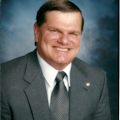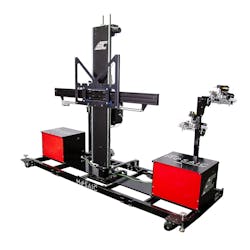Vehicles affected: All late model vehicles
Tools used:
· Wheel aligner
· Digital or laser level
· Plumb bob
· Scan tool
· ADAS calibration equipment
Check vehicle make and model
You have undoubtedly heard a lot about advanced driver assistance systems (ADAS) over the past few years, but are you sufficiently aware of the impact it will have on your business today and in the future?
With virtually every vehicle manufactured throughout the past few years having some aspect of ADAS as part of its safety and driver convenience systems, the probability that you will need to either diagnose, repair, or at a minimum interact with these components is inescapable. These interactions can include being aware of sensors, cameras, and other components in order to avoid disturbing them, or diagnosing, repairing, replacing, and even calibrating these components or systems.
The make and model of vehicles that visit your shop, as well as the services your shop performs, will determine how often you and your technicians will interact with ADAS components. It will surprise you how many times you see these systems in your shop going forward. To fully understand how many times you see them, perform a little experiment. This experiment could take time, but the investment will be worthwhile when you understand how many vehicles require some type of additional service of the ADAS after normal repairs. This effort can not only save you time and frustration in the long run, but it can become a profit center.
Make a brief list of the vehicles and the repairs they need that are currently in your shop. Using the list, find out which ADAS components will need to be disturbed then subsequently calibrated. This can be done in one of a few ways. In your vehicle repair information system, look up the recommended repair process and the required tools to complete the job. If you have Mitchell 1, there is a button near the top banner of the screen that is labeled ADAS. This button takes you directly to a section that lists the different ADAS on the vehicle and the repairs that will require a calibration or other action after or during the repair.
I spoke with Ben Johnson, director of product management at Mitchell 1, and he told me according to their usage information, this ADAS shortcut is being used approximately 30 percent of the time in collision shops, but only around 2 percent of the time in aftermarket repair shops. This is interesting from both the collision and repair shop perspectives. First off, collision centers will probably see damaged components more often than repair shops, creating more need to look up ADAS procedures. Secondly, most insurance companies are now adding the time for repairing and calibrating these systems in their estimating software, possibly helping the collision shop to become more aware of these systems. Lastly, once collision shops repair an ADAS component on a vehicle, the need to look up calibration or repair procedures diminishes, especially if the shop sees consistent makes and models.
Why calibration after repair is so important
When it comes to ADAS and repair shops, I am somewhat concerned that there are not enough shops paying attention to the need to calibrate these systems after completing traditional repair services. Most late model vehicles will require an ADAS calibration after a thrust alignment. According to Kaleb Silver from Hunter Engineering, the company’s latest versions of software for their computerized aligners notify the user if any calibrations are required during or after the alignment procedure. This is a great reason to maintain the subscriptions on your aligner in order to have the most current information available.
Since it seems as though most shops are not looking up the procedures for repairing or calibrating ADAS, the likelihood that these repairs are incomplete is quite high. My concern is if your shop is not calibrating a system, or even making sure the components are realigned properly, will the safety aspect of ADAS your customer is relying on be functioning when they need it? From a potential liability standpoint, can you afford to not complete the repair to make sure everything is working as designed?
Even the smallest misalignment of a forward-facing radar or camera can cause the system to misjudge objects by a full lane, making the collision warning/avoidance aspect of the system ineffective. I am sure you have heard the cost of ADAS aligning and calibrating equipment is enormously expensive. Here is the reality: some of the calibration equipment could be considered expensive, but the tools required to perform some of the small adjustments, and in some cases adjustments prior to calibrating a system, are relatively inexpensive.
These tools include a laser or digital level which you will use to make sure the components are level to the vehicle, and a plum bob required to find the center of the vehicle. A note of caution here – you need to make sure to compensate for any floor slope when you are leveling components to make sure their alignment is accurate.
Replacing steering or suspension components will require ADAS alignment due to possible ride height and wheel alignment changes. After a wheel alignment, especially a rear thrust adjustment, the forward or rear facing camera angles can have substantial changes, so their re-positioning is essential.
What you'll need, and need to know
There are basically three methods to re-align or calibrate ADAS. One is adjusting individual components using a designated tool from the vehicle manufacturer, or a level to make sure the position of the component is aligned properly in the vehicle. The other two methods are either a static calibration, meaning the vehicle is stationary in the shop, or a dynamic calibration, meaning a specific drive cycle is performed after the vehicle is placed in a calibration mode.
There is and has been a lot of speculation about how long car makers will continue to use static calibrations, but based on conversations I have had with experts in the field, the challenges of dynamic calibrations all but guarantee that static calibrations are here to stay. Some of the challenges of dynamic calibrations include the ability to perform them year-round, as they need to be driven on a clear day without the sun shining too brightly into a camera. Additionally, most dynamic calibrations require clearly marked lanes, and the vehicle needs to be driven at a steady speed over 45 mph, which depending on traffic in your locale, may be nearly impossible.
The largest objection to shops performing static calibrations are two-fold: the cost of the equipment and the space required to perform them. Let’s discuss the space requirement first. With some exceptions, the space required for static calibrations is a fully open bay, measuring approximately 30’ by 16’. Some wheel aligners can be about the same size, and some alignment machines have ADAS adaptability. The next objection is cost, which could be considered in one of two ways. Shop owners might view cost as a very expensive piece of equipment or as an investment opportunity to the future with a pretty good ROI. If you have had to send a vehicle out for a calibration, you have most likely had to deal with a few things. One is the inconvenience of sending, possibly towing, a vehicle out to a dealer that has the calibration equipment. Then there is the time to get the vehicle scheduled at the dealer, which can be a couple of weeks depending on their backlog. There is also the cost of the calibration, which can run anywhere from $150 to $500 depending on the system.
The alternative is to invest in your future with a system of your own. I’m not saying that every shop can afford to jump into the calibration business, but there is an opportunity for many of you to do so. Think about this: If you were to market to other repair shops and collision centers in your area, how many calibrations could you perform for them? These opportunities, along with the results of the survey you did on vehicles in your shop now, could give you a fairly good idea of the size of the market. Another thing to consider is if you purchased a top-of-the-line alignment machine, you may have spent around $40,000, about the same as ADAS calibration equipment. The ROI on an aligner does not pencil out as good as ADAS calibration equipment if you consider you can do just as many alignments in a day as you could calibrations, being that calibrations can be sold at almost twice the rate of an alignment service.
The newest wave of ADAS equipment includes lower cost innovations like printing your own targets and DIFM (Do it for Me) remote calibration systems, such as the Mosaic ADT system from Chief Collision Technology. The Mosaic is a complete system that is installed in the shop where your trained technician connects the vehicle and sets the system up before a remote technician from Chief performs the calibration. This system performs a calibration quickly and frees up your technician during the process so they are able to continue to be productive elsewhere. Another advantage of the Mosaic system is that as vehicle manufacturers update software, the responsibility of staying current with such software falls on the tool manufacturer rather than you and your technicians.
When it comes to billing your customer for a necessary calibration, you will most likely need to educate them on what ADAS is and why it is necessary to maintain the system by performing calibrations. In order to do so, you and your service advisors will need to educate yourselves on the various systems, the issues that could arise from not calibrating them, and which repairs require ADAS calibration.
Be sure to address calibration aspects specifically within a repair order to protect yourself in a potential liability case. For example, you should think twice about just writing, “ADAS calibration.” Consider writing the specific component calibrations performed, such as, “Performed forward-facing radar calibration. System is performing as designed at this time.”
Face it, ADAS is here to stay. The sooner you jump in to do the repairs, the sooner you can take advantage of a relatively open market.
About the Author

Barry Hoyland
Barry Hoyland has been in the independent aftermarket for more than 45 years as a technician, technician instructor, shop owner, and shop management consultant. He owned and operated a successful Southern California automotive repair center that offers complete auto care and specialized in emission and diagnostic services for over 28 years. Hoyland also owned a company that modified vehicles to perform as emergency response units and mobile command centers, incorporating high-end electronic components into today’s vehicles. Hoyland has experience with all size and types of vehicles including traditional gas, hybrid electric, alternative fuel, and heavy duty diesel trucks.
Hoyland has provided consulting services for many automotive shops, fleets, and government agencies in order to improve their operational efficiencies.
In addition, he has worked with many NHRA drag racing teams as a crew chief on supercharged alcohol and nitro-methane fueled cars and currently serves as a crew chief on a Top Alcohol Funny Car, a Nostalgia Funny Car, and a Nostalgia Alcohol Dragster
Hoyland holds certifications in ASE: A1, A6, A8, and L1, MACS 609, maintains a California Advanced Emission license, and a CDL with endorsements for double and triple trailers, tankers, and HazMat.
When he is not helping to run a shop in the Pacific Northwest, Hoyland travels across the U.S. as an instructor of technical and shop management courses, many of which he has developed.
